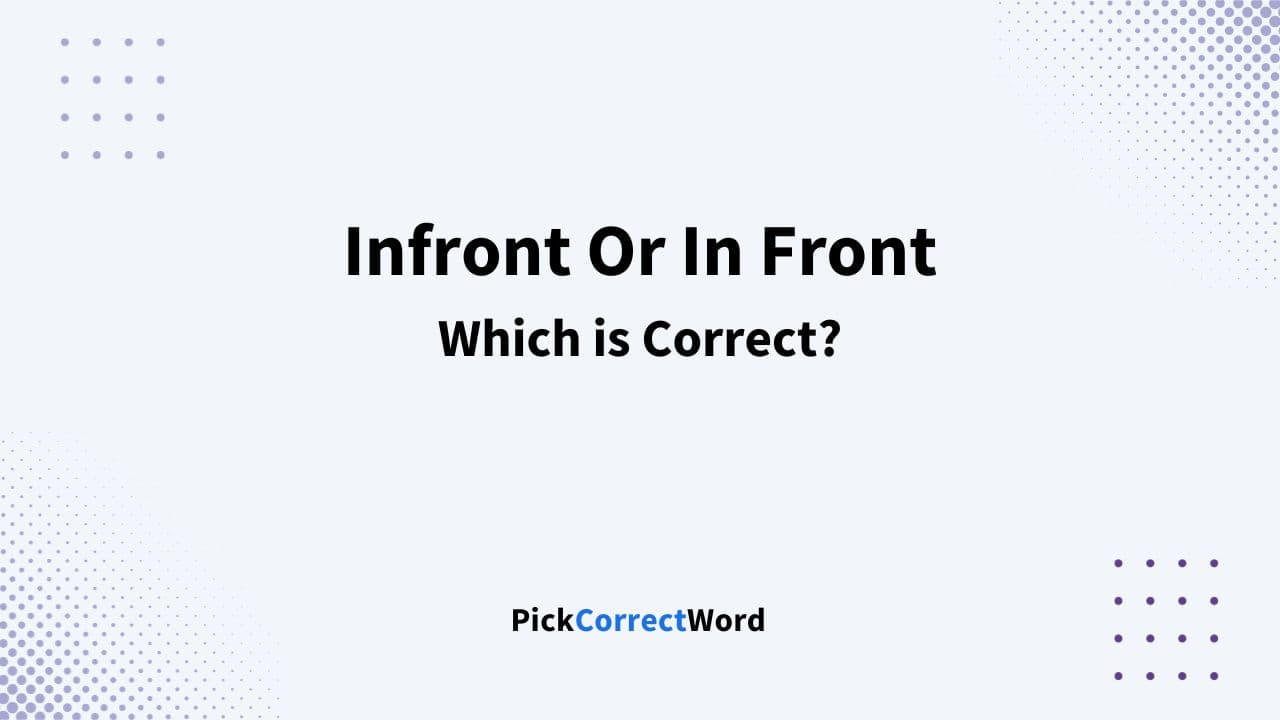The correct term to use is ‘in front’; using ‘infront’ is a common mistake and isn’t recognized in standard English.
When someone or something is ahead or before another object or person, you would say they are ‘in front’ of it. There’s no word such as ‘infront’ in the English dictionary, making its usage incorrect.
It’s crucial for you, as a learner, to remember to separate ‘in’ and ‘front’ with a space to convey the meaning accurately.
Infront or In front: Which is correct?
The correct phrase is “in front” rather than “infront.” Having clarity in your writing is crucial, and understanding the difference between these two forms is important for your usage of standard English.
Understanding ‘In Front’ as a Phrase
The term “in front” is a standard prepositional phrase in English, meaning “ahead” or “before.” It’s used to denote the position of something relative to something else.
For example, “The car is in front of the house.”
Grammatical Basis for saying In Front and not Infront
Grammatically, in front is the correct form.
“In front” is a two-part expression that combines the preposition “in” with the noun “front,” indicating a position ahead of or before another point or object.
English language typically maintains space between a preposition and its object. Joining these two would be against word formation rules and thus incorrect.
On the other hand, infront is not a recognized word in standard English.
Most likely, the confusion comes from words like “inside,” “into,” or “inward.” However, “in front” does not fall into this class of words.
Examples of using “In Front” in a Sentence
“She stood in front of the mirror practicing her speech.”
“The parking space in front of the building is reserved.”
“There’s a lovely garden in front of their house.”
“The lead runner is consistently in front during the race.”
“She always feels nervous when speaking in front of a crowd.”
“The bodyguard walked in front of the celebrity to ensure safety.“
Other Correct Ways of Saying: “In Front”
You can express the concept of being in a forward position using various phrases.
Different phrases can be used to describe being in a forward position. You could say “ahead,” which means that someone or something is ahead of other people in terms of position or progress.
You can also say “at the forefront,” which is often used to talk about being in the lead when it comes to innovation or thought leadership.
Synonymous Terms:
- Ahead: Often implies being in front in a race or progression.
- Foremost: Suggests being in the most advanced or important position.
- Forward: Can imply a position towards the front.
- Leading: Denotes a position at the front, usually indicative of rank or progress.
Example Sentences:
“He is at the forefront of medical research, leading the way with innovative treatments.”
“She stood ahead of the group, scanning the horizon for signs of their destination.”
“The organization is foremost in advocating for human rights, setting an example for others to follow.”
“Their team is forward in the standings, reflecting a series of successful matches.”
Frequently Asked Questions
Is “infront” the correct spelling in English?
No, “infront” is not recognized as a correct spelling. The correct form is two separate words: “in front.”
When is it appropriate to use “in front”?
The term “in front” is used to indicate a position ahead or before something or someone. For example, “Please wait in front of the building.”
How can I remember the correct form to use?
Remember that “in” and “front” are two separate words, and like other prepositional phrases, a space is always required between them.


